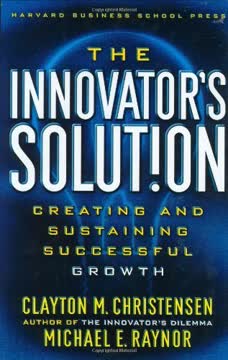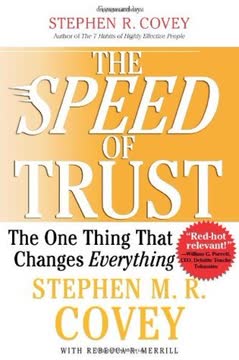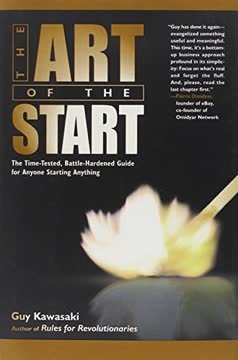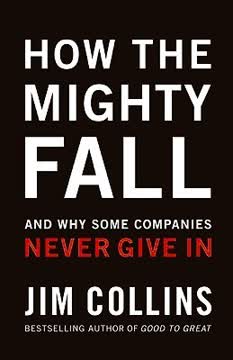Key Takeaways
1. Great companies can fall: Success breeds complacency and hubris
Success is viewed as "deserved," rather than fortuitous, fleeting, or even hard earned in the face of daunting odds; people begin to believe that success will continue almost no matter what the organization decides to do, or not to do.
Arrogance of success. Companies that achieve greatness often fall victim to their own success. They develop a sense of invincibility and entitlement, believing their past achievements guarantee future triumphs. This hubris blinds them to changing market conditions, emerging competitors, and internal weaknesses.
Neglect of core strengths. As organizations grow complacent, they often neglect the very factors that made them successful in the first place. They may lose sight of their core values, neglect customer needs, or fail to innovate. This erosion of foundational strengths leaves them vulnerable to more agile and hungry competitors.
Examples of fallen giants. The book cites numerous examples of once-great companies that succumbed to hubris, including:
- Motorola: Dominated the cell phone market but failed to adapt to digital technology
- Circuit City: Led consumer electronics retail but neglected customer service and store experience
- A&P: America's largest retailer for decades, but resisted change and modernization
2. Undisciplined pursuit of more leads to overreaching
Undisciplined discontinuous leaps: The enterprise makes dramatic moves that fail at least one of the following three tests: 1. Do they ignite passion and fit with the company's core values? 2. Can the organization be the best in the world at these activities or in these arenas? 3. Will these activities help drive the organization's economic or resource engine?
Reckless expansion. In their eagerness to grow, companies often pursue opportunities that lie outside their core competencies or values. This undisciplined expansion stretches resources thin and dilutes focus, leading to subpar performance across the board.
Breaking Packard's Law. Named after Hewlett-Packard co-founder David Packard, this principle states that no company can grow revenues faster than its ability to get the right people to implement that growth. Violating this law leads to:
- Hiring the wrong people to fill key positions
- Implementing bureaucratic procedures to compensate for inadequate talent
- Driving away top performers who chafe under increased bureaucracy
Examples of overreach:
- Ames Department Stores: Acquired Zayre stores, doubling in size overnight but lacking the capacity to manage the expansion
- Bank of America: Aggressively expanded international lending without proper risk assessment
- Rubbermaid: Pursued rapid product innovation (one new product per day) at the expense of profitability and operational efficiency
3. Denial of risk and peril blinds leaders to mounting threats
When faced with ambiguous data and decisions that have a potentially severe or catastrophic downside, leaders take a positive view of the data and run the risk of blowing a hole "below the waterline."
Selective data interpretation. Leaders in denial tend to amplify positive information while discounting or explaining away negative data. This creates a distorted view of reality, preventing the organization from addressing critical issues.
Externalizing blame. Rather than accepting responsibility for setbacks, leaders in Stage 3 often point to external factors or scapegoats. This deflection prevents honest self-assessment and necessary course corrections.
Warning signs of denial:
- Consistently explaining away poor results
- Focusing on short-term performance at the expense of long-term health
- Chronic restructuring without addressing fundamental issues
- Deterioration of open, honest dialogue within the leadership team
- Increasing gap between public statements and private realities
4. Grasping for salvation through bold, untested strategies often backfires
The signature of mediocrity is not an unwillingness to change. The signature of mediocrity is chronic inconsistency.
Silver bullet syndrome. Companies in Stage 4 often seek quick fixes or dramatic transformations to reverse their decline. These may include:
- Bet-the-company acquisitions or mergers
- Radical strategy shifts
- Hiring a charismatic outsider CEO as a savior
- Launching revolutionary products or entering entirely new markets
Panic and haste. The pressure to turn things around quickly leads to hasty, poorly thought-out decisions. Leaders may abandon core strengths in pursuit of the latest management fads or industry trends.
Examples of failed salvation attempts:
- Hewlett-Packard: Hiring celebrity CEO Carly Fiorina and pursuing a controversial merger with Compaq
- Circuit City: Firing experienced sales staff to cut costs, then attempting a buyout when results deteriorated
- Motorola: Making a massive bet on the Iridium satellite phone system, which ultimately failed
5. Capitulation to irrelevance or death is the final stage of decline
You pay your bills with cash. You can be profitable and bankrupt.
Running out of options. By Stage 5, companies have exhausted their financial and strategic resources. They may face:
- Mounting debt and dwindling cash reserves
- Loss of key talent and institutional knowledge
- Erosion of customer base and brand value
- Technological obsolescence or market irrelevance
Two paths in Stage 5:
- Selling out or merging: Accepting the loss of independence to salvage some value (e.g., Scott Paper selling to Kimberly-Clark)
- Dissolution or bankruptcy: Running out of viable options and ceasing operations (e.g., Circuit City's liquidation)
Lessons from Stage 5:
- Cash is king: Profitability alone doesn't ensure survival
- Options narrow over time: Earlier intervention provides more room for maneuver
- Recovery becomes exponentially harder in later stages of decline
6. Recovery is possible through disciplined people, thought, and action
The path out of darkness begins with those exasperatingly persistent individuals who are constitutionally incapable of capitulation.
Level 5 Leadership. Successful turnarounds are often led by humble, determined leaders who:
- Put the organization's interests above their own ego
- Confront brutal facts while maintaining unwavering faith in ultimate success
- Build a culture of discipline and accountability
First Who, Then What. Prioritize getting the right people in key positions before determining strategy. This ensures:
- A team capable of brutal honesty and rigorous debate
- Execution ability to implement chosen strategies
- Flexibility to adapt as circumstances change
Key elements of successful recoveries:
- Returning to core values and strengths
- Rigorous, fact-based analysis of the situation
- Disciplined, consistent execution of chosen strategies
- Building momentum through a series of small wins
- Patience and perseverance in the face of setbacks
7. Preserving core values while stimulating progress is key to lasting success
Bad decisions made with good intentions are still bad decisions.
Timeless core, timely practices. Great companies maintain a balance between preserving their fundamental identity and adapting to a changing world. This involves:
- Clearly defining and adhering to core values and purpose
- Continuously evolving strategies, practices, and goals
- Fostering a culture that embraces both tradition and innovation
Productive paranoia. Even in good times, great leaders maintain:
- A sense of urgency about potential threats and opportunities
- Continuous self-examination and improvement
- Conservative financial practices to weather unforeseen storms
Building to last:
- Develop mechanisms to preserve core values across generations of leadership
- Cultivate a deep bench of internal talent aligned with the company's mission
- Set Big Hairy Audacious Goals (BHAGs) to drive progress while staying true to core purpose
- Create a clock-building culture that transcends dependence on any single leader or idea
Last updated:
FAQ
What's "How The Mighty Fall" about?
- Focus on decline: "How The Mighty Fall" by Jim Collins explores why once-great companies decline and how they can potentially recover.
- Five stages of decline: The book outlines a framework of five stages that companies typically go through as they fall from greatness.
- Research-based insights: Collins uses extensive research and case studies to illustrate how decline can happen even to seemingly invincible companies.
- Hope for recovery: The book also offers insights into how companies can detect early signs of decline and reverse their downward trajectory.
Why should I read "How The Mighty Fall"?
- Understanding failure: It provides a deep understanding of the factors leading to corporate failure, which is crucial for business leaders and managers.
- Preventive strategies: The book offers strategies to prevent decline, making it a valuable resource for sustaining business success.
- Real-world examples: Through case studies, readers can learn from the mistakes and successes of other companies.
- Hope and recovery: It emphasizes that decline is not inevitable and that recovery is possible with the right actions.
What are the key takeaways of "How The Mighty Fall"?
- Five stages of decline: The stages include Hubris Born of Success, Undisciplined Pursuit of More, Denial of Risk and Peril, Grasping for Salvation, and Capitulation to Irrelevance or Death.
- Self-inflicted decline: Most declines are self-inflicted and can be reversed if detected early.
- Leadership's role: The wrong leadership can accelerate decline, while disciplined leadership can prevent or reverse it.
- Importance of core values: Maintaining core values and disciplined practices is crucial for long-term success.
What are the five stages of decline according to Jim Collins?
- Stage 1 - Hubris Born of Success: Companies become arrogant and lose sight of the factors that made them successful.
- Stage 2 - Undisciplined Pursuit of More: Companies overreach, pursuing growth without discipline or strategic alignment.
- Stage 3 - Denial of Risk and Peril: Warning signs are ignored, and leaders downplay negative data.
- Stage 4 - Grasping for Salvation: Companies make desperate moves for quick fixes, often seeking a savior leader or strategy.
- Stage 5 - Capitulation to Irrelevance or Death: Companies give up the fight, leading to irrelevance or closure.
How can companies detect early signs of decline?
- Monitor key metrics: Keep an eye on financial ratios, customer loyalty, and employee engagement for early warning signs.
- Encourage open dialogue: Foster a culture where employees feel safe to share bad news and confront brutal facts.
- Avoid complacency: Continuously question and validate the factors driving success to prevent arrogance.
- Focus on core values: Ensure that the company’s core values and purpose remain central to its operations.
What role does leadership play in preventing decline?
- Level 5 leadership: Leaders should be ambitious for the company, not themselves, and have the resolve to do what it takes for success.
- Succession planning: Effective succession planning is crucial to maintain continuity and prevent decline.
- Disciplined decision-making: Leaders should make decisions based on empirical evidence and strategic alignment.
- Avoiding savior complex: Leaders should focus on building a strong team and culture rather than relying on a single charismatic figure.
What is the "Hedgehog Concept" in "How The Mighty Fall"?
- Core focus: The Hedgehog Concept involves focusing on what a company can be the best at, what drives its economic engine, and what it is deeply passionate about.
- Strategic alignment: It helps companies align their strategies with their core strengths and market opportunities.
- Avoiding distractions: By adhering to the Hedgehog Concept, companies can avoid the pitfalls of undisciplined growth.
- Long-term success: It is a key factor in sustaining long-term success and avoiding decline.
How does "How The Mighty Fall" suggest companies can recover from decline?
- Return to basics: Companies should return to sound management practices and strategic thinking.
- Focus on core strengths: Rebuild momentum by focusing on core competencies and values.
- Disciplined execution: Implement a series of well-executed decisions to build cumulative momentum.
- Leadership and culture: Cultivate disciplined leadership and a strong, value-driven culture.
What are some real-world examples discussed in "How The Mighty Fall"?
- Motorola: The book discusses Motorola's fall due to arrogance and undisciplined growth.
- HP: HP's struggles with leadership changes and strategic missteps are analyzed.
- Fannie Mae: The book examines Fannie Mae's decline during the financial crisis.
- IBM: IBM's recovery under Lou Gerstner is highlighted as a successful turnaround story.
What are the best quotes from "How The Mighty Fall" and what do they mean?
- "The signature of mediocrity is not an unwillingness to change. The signature of mediocrity is chronic inconsistency." This highlights the danger of erratic changes without a coherent strategy.
- "Great companies can stumble, badly, and recover." This emphasizes that decline is not irreversible and recovery is possible with the right actions.
- "We are not imprisoned by our circumstances, our setbacks, our history, our mistakes, or even staggering defeats along the way. We are freed by our choices." This underscores the power of choice in determining a company's fate.
How does "How The Mighty Fall" relate to Jim Collins' other works?
- Continuation of themes: The book builds on concepts from "Good to Great" and "Built to Last," focusing on the decline aspect.
- Research-based approach: Like his other works, Collins uses rigorous research and case studies to support his findings.
- Frameworks for success: It complements the frameworks for achieving greatness by providing insights into avoiding and reversing decline.
- Holistic view: Together, Collins' books offer a comprehensive view of building, sustaining, and recovering greatness.
What is the significance of the "Flywheel" concept in "How The Mighty Fall"?
- Momentum building: The Flywheel concept emphasizes the importance of building momentum through consistent, disciplined actions.
- Avoiding doom loop: It contrasts with the doom loop of erratic, reactive changes that lead to decline.
- Cumulative effect: Success is achieved through the cumulative effect of small, well-executed decisions.
- Sustained progress: The Flywheel is a metaphor for sustained progress and long-term success.
Review Summary
How the Mighty Fall examines why successful companies decline, identifying five stages of decline. Readers found it insightful for both business and personal applications, praising Collins' research and accessible writing. Some criticized the lack of rigorous data analysis, while others appreciated the practical lessons and cautionary tales. The book's concise format and focus on failure rather than success were seen as strengths. Many readers considered it valuable for leaders, entrepreneurs, and anyone interested in organizational or personal performance.
Similar Books










Download PDF
Download EPUB
.epub digital book format is ideal for reading ebooks on phones, tablets, and e-readers.











